Are you considering an Oman road trip and have at least 10 days to spare? We’ll show you a great 10-day itinerary and reveal what awaits you in the north of Oman. Look forward to bustling markets, historic fortresses, picturesque oasis towns, endless dream beaches, glowing red sand dunes, imposing gorges, and impressive mountain ranges.
Our own 17-day tour took us across the country. We explored both the north and the south and experienced a wide variety of adventures. It was an intense, beautiful, and exciting tour that we won’t soon forget. And it certainly wasn’t the last trip to this country.
What else you should know
- What else you should know
- Who is an Oman road trip suitable for?
- Oman Road Trip – Itinerary & Duration
- Oman Round Trip – Highlights & Sights
- Day 1 – Arrival in Muscat
- Day 2 – Sultan Qaboos Mosque & Royal Opera House
- Day 3 – Daymaniat Islands
- Day 4 – Birkat al Mouz & Nizwa
- Day 5 – Jebel Shams
- Day 6 – Misfah al Abriyyin
- Day 7 – Ibra & Wahiba Sands Desert
- Day 8 – Wadi Bani Khalid and Sur
- Day 9 – Wadi Shab & Wadi Al Arbeieen
- Day 10 – Return journey and departure
- General Oman travel tips
- Arrival – How do I get to Oman?
- Entry – What do I need to bear in mind when entering the country?
- Rental car – Do I really need a 4×4?
- Travel time – When is the best time to travel to Oman?
- Safety – How safe is a trip through Oman?
- Costs – How much does a round trip like this cost?
- Packing list – What should not be missing from your luggage?
Who is an Oman road trip suitable for?
A round trip through Oman is suitable for everyone who enjoys immersing themselves in foreign cultures, is open to new things, and loves spectacular landscapes. Since traveling in Oman is generally very easy, you don’t have to be an extreme adventurer for an Oman road trip. You can travel safely and relaxed through the country with a rental car and gain your own experiences.
Since the country has a rich history and many cultural traditions, a trip is particularly exciting for culture vultures. In the historic cities, impressive fortresses, and traditional villages, you can experience the culture and people of Oman up close. They are known for their genuine hospitality and friendliness.
So if you’re interested in a diverse country and enjoy traveling independently, you should venture on an Oman road trip. The country welcomes you with open arms and a very good tourist infrastructure. Oman is also one of the safest countries in the world, so you don’t have to worry about security.
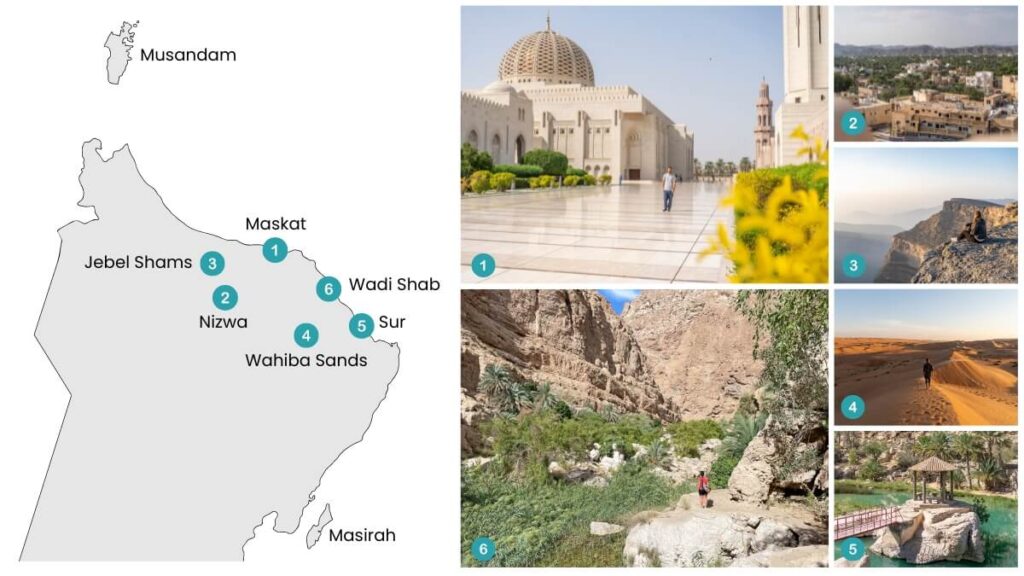
Oman Road Trip – Itinerary & Duration
We recommend at least 7 to 10 days for a trip to Oman. If you have more time, all the better! For 10 days, we highly recommend a trip through the north of the country, as you can experience a variety of adventures and get a very good impression of the country. If you have more time, you can make a detour to the south (Salalah). Take a look here: Our 17-day Oman tour.
10-day road trip through Oman’s north
Overnight stops:
- 3 nights in Muscat
- 1 night in Nizwa
- 1 night in Jebel Shams
- 1 night in Misfah al Abriyyin
- 1 night in Wahiba Sands
- 1 night in Sur/Wadi Shab
- 1 night in Wadi Al Arbeieen
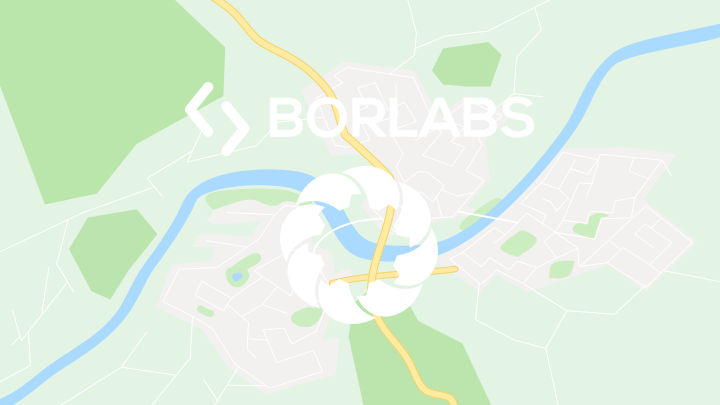
By loading the map, you accept Google’s privacy policy.
Learn more
Load map
Oman Round Trip – Highlights & Sights
Day 1 – Arrival in Muscat
It’s best to book a night flight from Germany so you can hit the ground running on your first day in Oman. From the airport, you can take a taxi to your accommodation (cost: 2 to 4 rials) or pick up your rental car and drive yourself. We didn’t pick up our car until day 4 because we didn’t want to drive ourselves in Muscat.

Once you arrive in Muscat, we recommend a walk along the promenade in Mutrah. Here, you can not only marvel at the Sultan’s enormous yacht in the harbor, but also at the Mutrah Fortress, the bustling souk, and, a little further away, the Sultan’s Palace (Al Alam Palace). We highly recommend the Bella Vista Café at the harbor (super delicious cheesecake & coffee). You can end the evening comfortably in one of the restaurants on Qurum Beach.
Hotel tips for Muscat:
- Aloft Hotel Muscat*
- Royal Tulip Muscat*
- Fraser Suites Muscat*
- Avani Muscat Hotel & Suites*
- W Muscat*

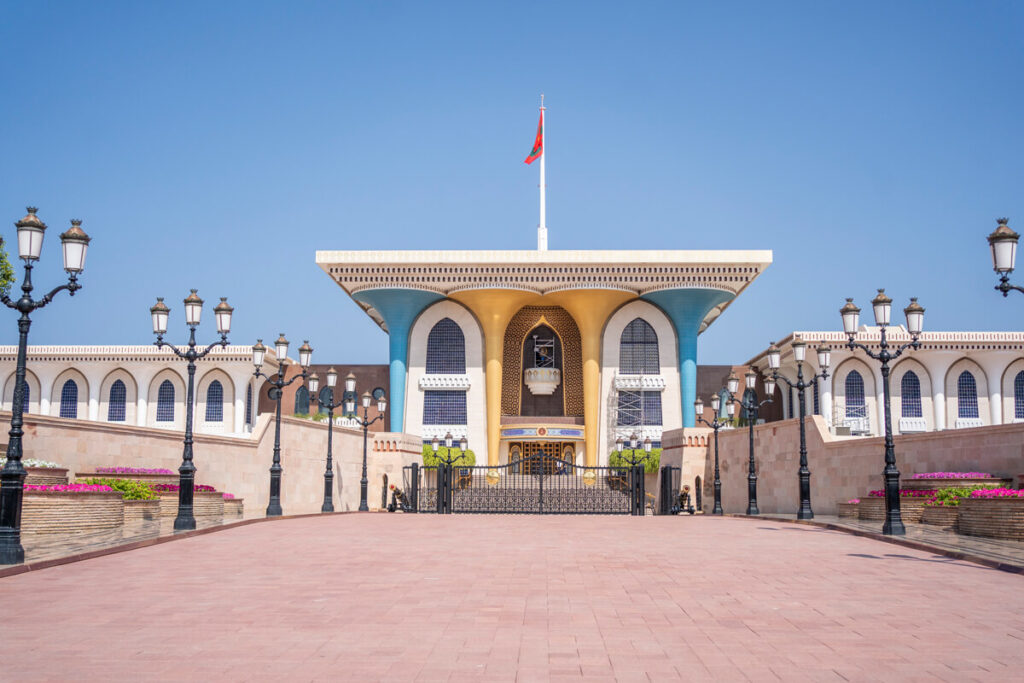

Day 2 – Sultan Qaboos Mosque & Royal Opera House
Early in the morning, you’ll first explore the impressive Sultan Qaboos Mosque. It’s only open to non-Muslims from Saturdays to Thursdays between 8 and 11 a.m. Women must cover their heads and wear long clothing, including a headscarf. For men, a T-shirt and shorts (knee-length) are acceptable.
Particularly beautiful features of this mosque are the beautifully landscaped flowerbeds surrounding it, the enormous chandelier with more than 1,000 lamps, the imposing dome, and the gigantic 22-ton carpet in the main hall, which is the largest prayer rug in the world. In general, the mosque in Muscat is a superlative building and is definitely one of the top highlights in Oman.
- Address: Sultan Qaboos St, Muscat, Oman
- Admission: free (guided tour can be booked on site)
- Clothing: can be rented on site
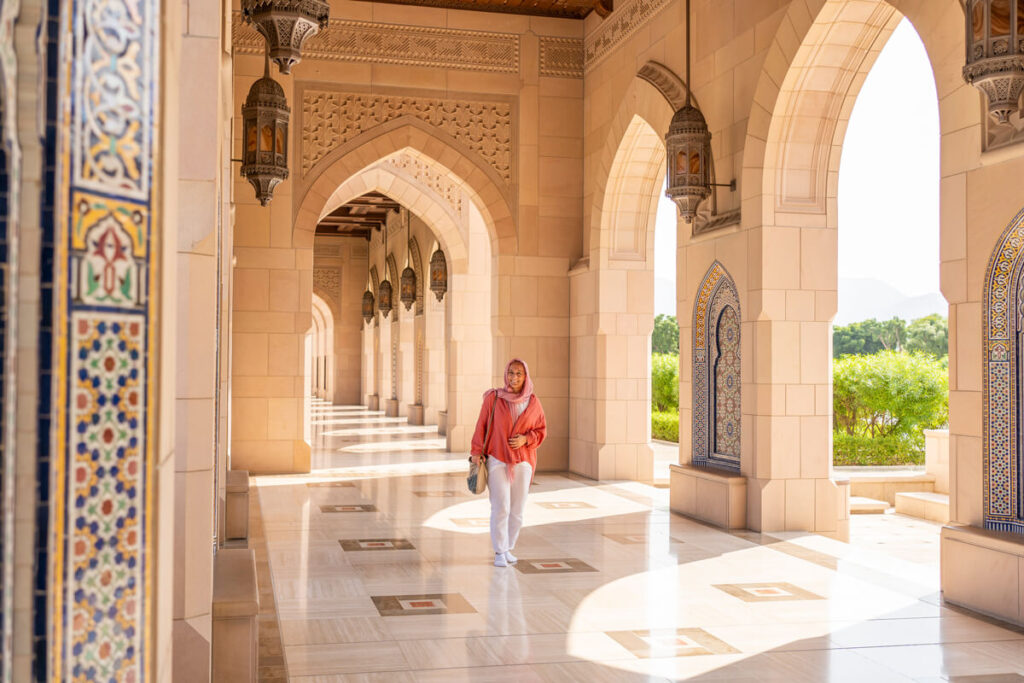


Your tour of Muscat then continues to the beautiful Royal Opera House (entrance fee: 3.15 rials). Opened in 2011, the Royal Opera House boasts a beautiful facade made of light and pink limestone from the Oman desert. Inside, you’ll find an impressive entrance area and a remarkable theater hall.
From the opera house, you can stroll to Qurum Beach and watch locals playing sports and soccer. Most locals only arrive at the beach in the early evening, when the heat gradually subsides. This is when Oman’s beaches are bustling with activity. Our restaurant tip for you: Rozna Restaurant (incredibly delicious traditional dishes).
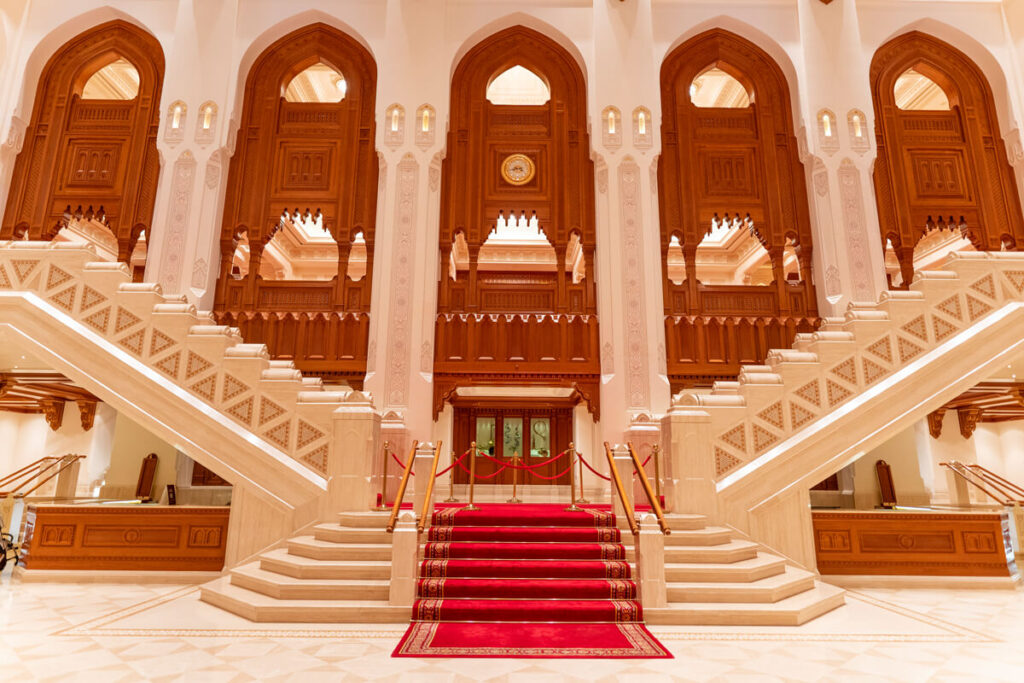
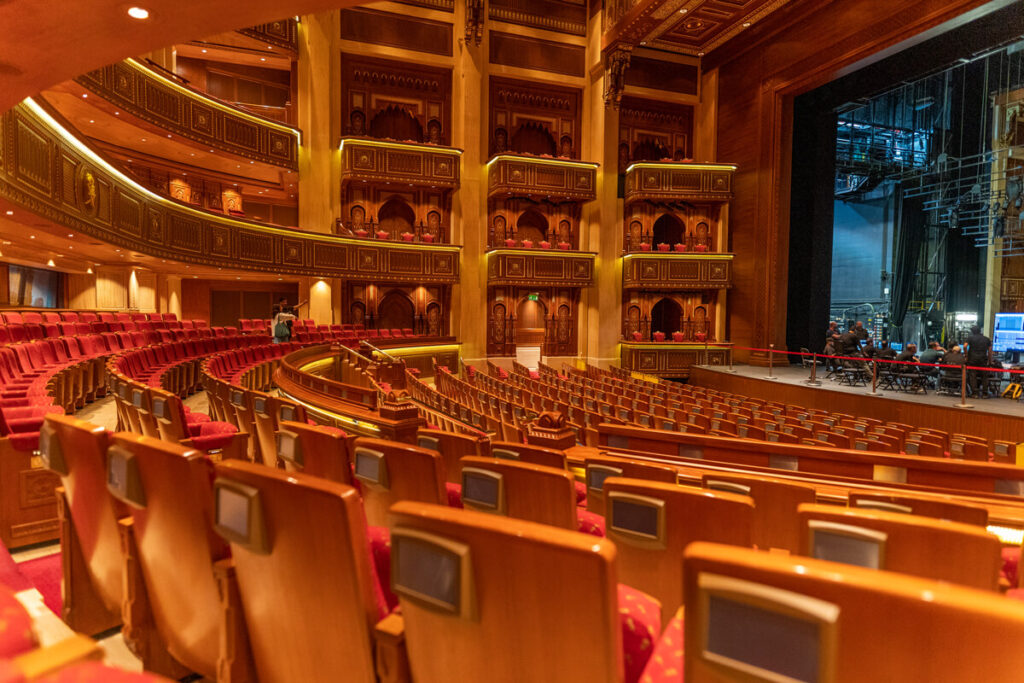
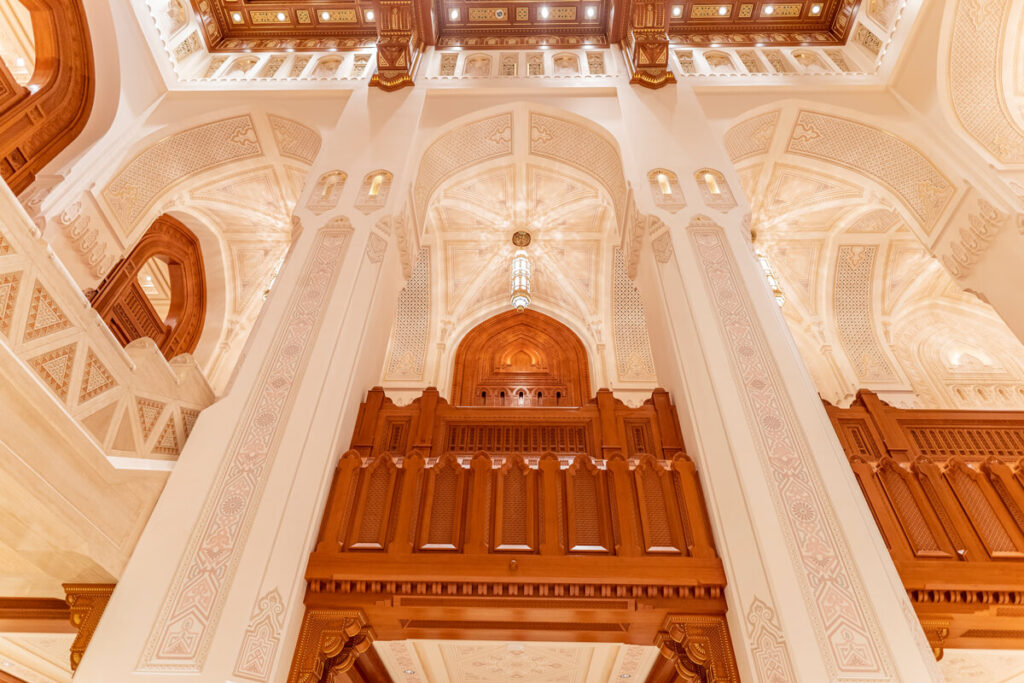
Day 3 – Daymaniat Islands
On the third day of your trip, you’ll embark on a very special adventure. From the port in Seeb, you’ll head to the Daymaniat Islands, a group of nine islands located approximately 18 km off the coast. Around these islands, you’ll find numerous great snorkeling and diving spots. With a bit of luck, you might even spot whale sharks between June and October. We saw countless reef sharks and turtles as well as lots of colorful fish.
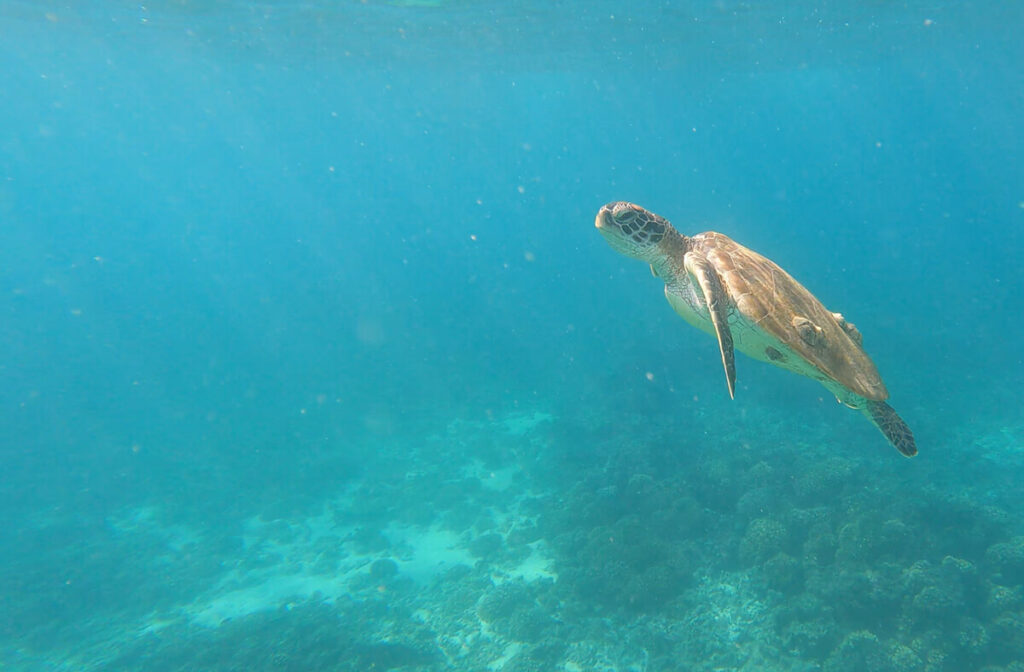
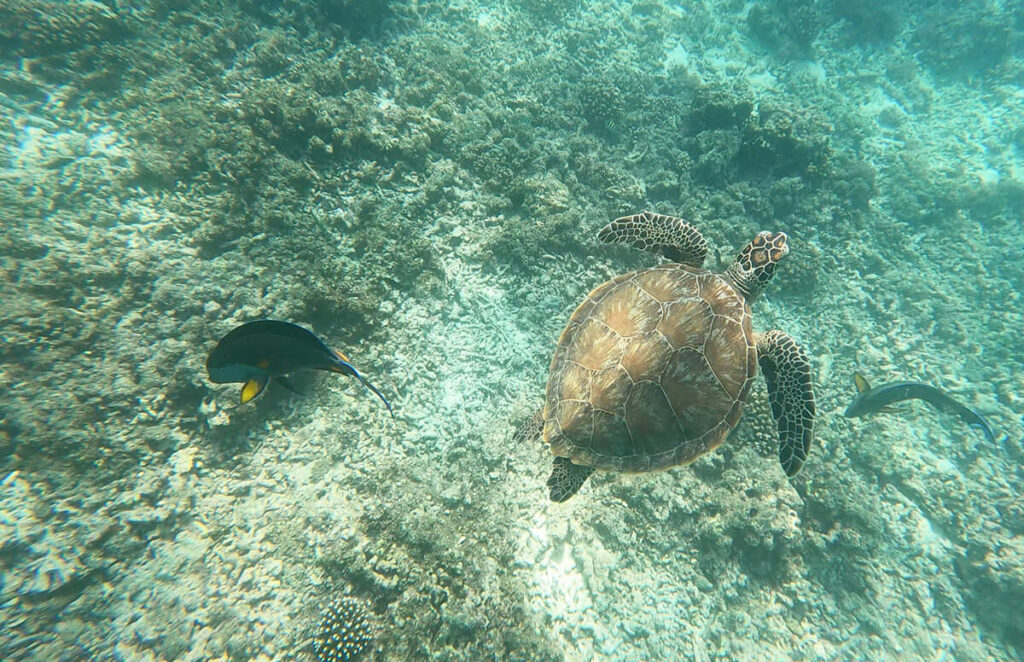
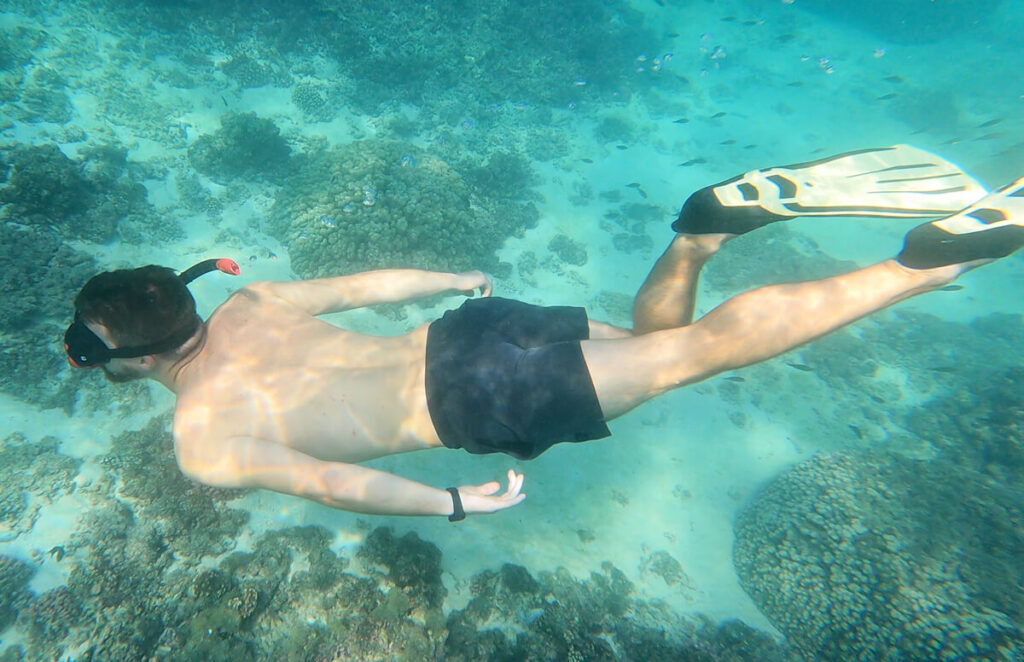
Day 4 – Birkat al Mouz & Nizwa
Now you leave Muscat and begin your exciting Oman road trip. On your way to the oasis town of Nizwa, you’ll stop in Birkat al Mouz. The small village with its extensive gardens and banana plantations has an old mud-brick district, which is largely abandoned. This forms a fascinating contrast to the rest of the town.
In Birkat al Mouz, you can discover the traditional irrigation system, a UNESCO World Heritage Site. Overhead and underground canals run through the town and are still used to transport water from the mountains to the individual plantations and gardens. Every now and then you can see locals with buckets and canisters fetching water.
Hotel tips for Nizwa and the surrounding area:
- Bait AlSabah Heritage Inn & Cafe*
- Aryaf Hostel*
- Nizwa Inn*
- Mazarah Heritage Inn*
- Antique Inn*
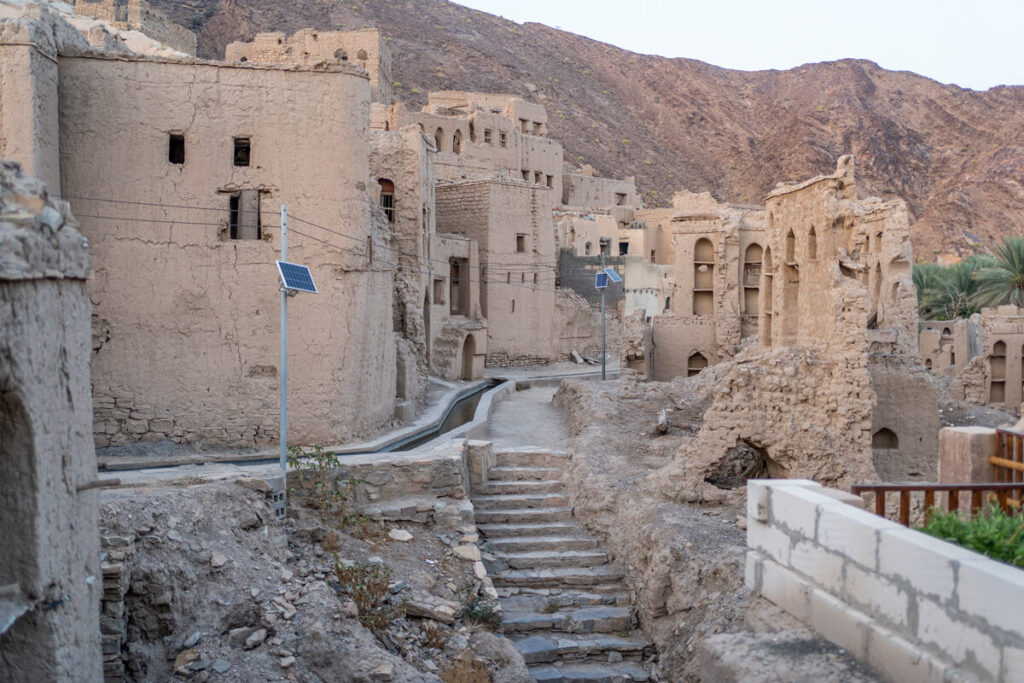
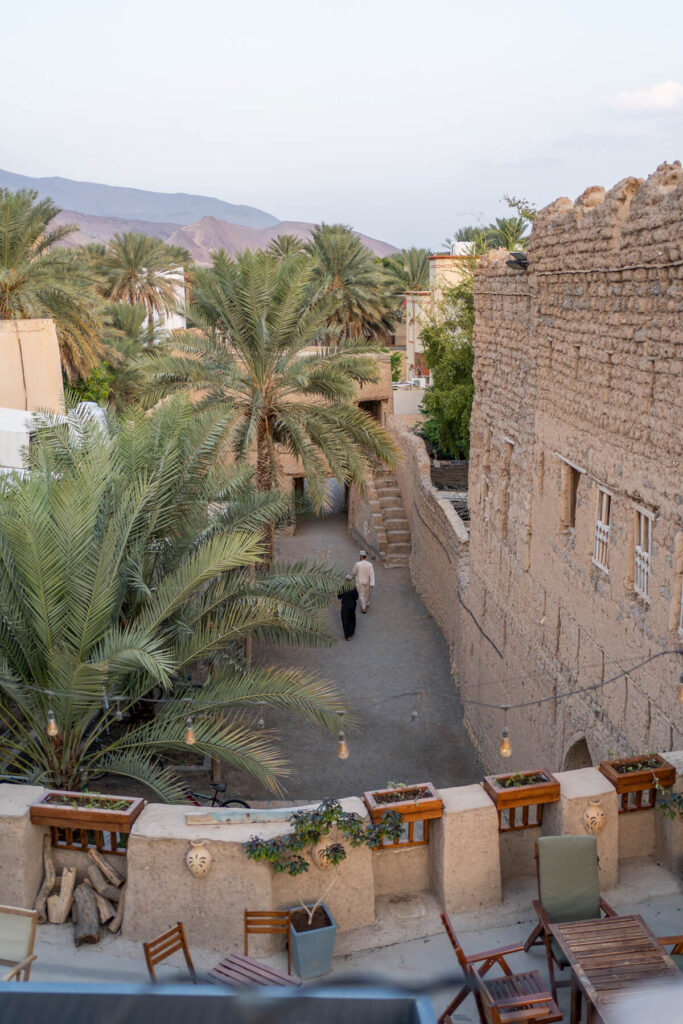
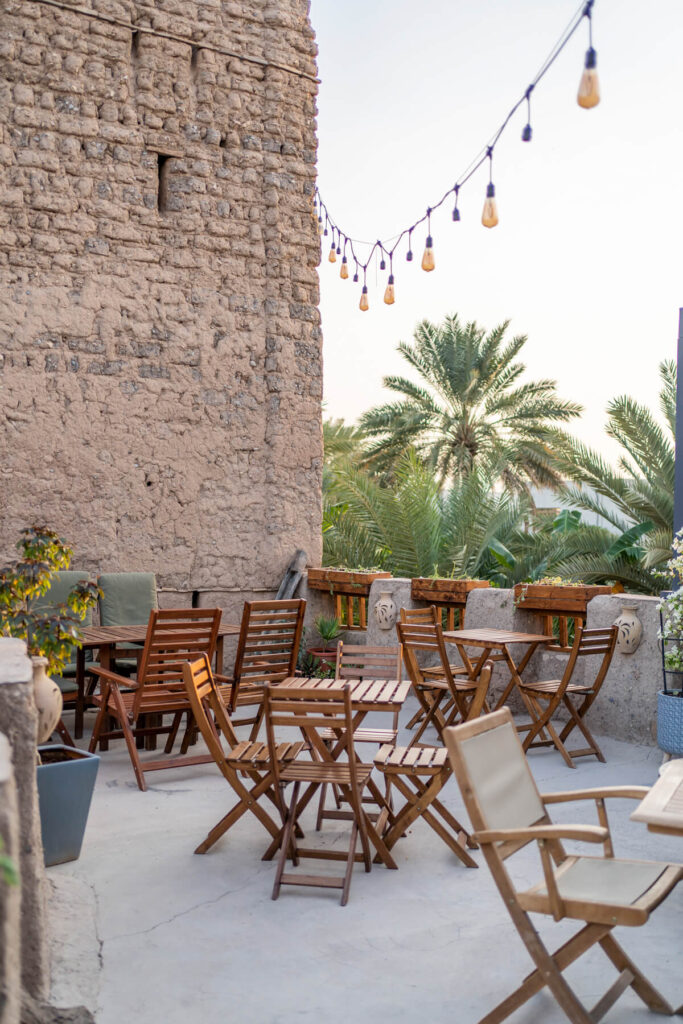
Now we continue a little further to the oasis town of Nizwa, one of the oldest towns in Oman and rich in history and culture. Don’t miss the 17th-century Nizwa Fort, the beautiful souk, and the surrounding plantations and oases. For a break, we recommend the Athar Café opposite the fortress. From the terrace, you can enjoy a direct view of the fortress.
Visitor Information Nizwa Fort
- Opening Hours Nizwa Fort: Daily from 8:00 a.m. to 8:00 p.m.
- Special Feature: Closed on Fridays from 11:30 a.m. to 1:30 p.m.
- Admission: Adults 5 rials, children discounted
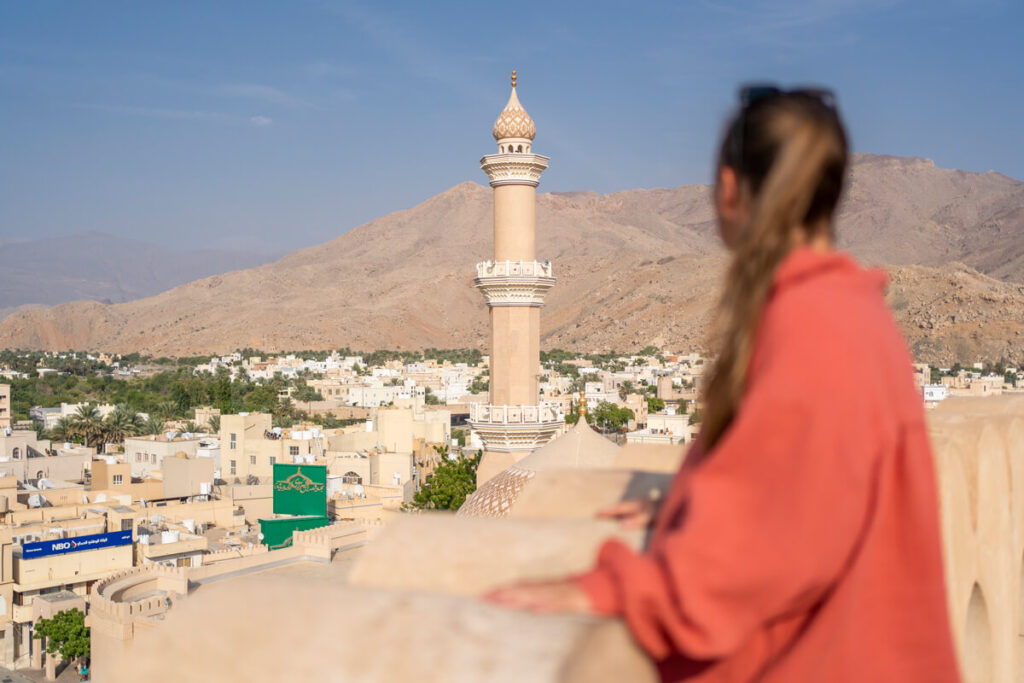
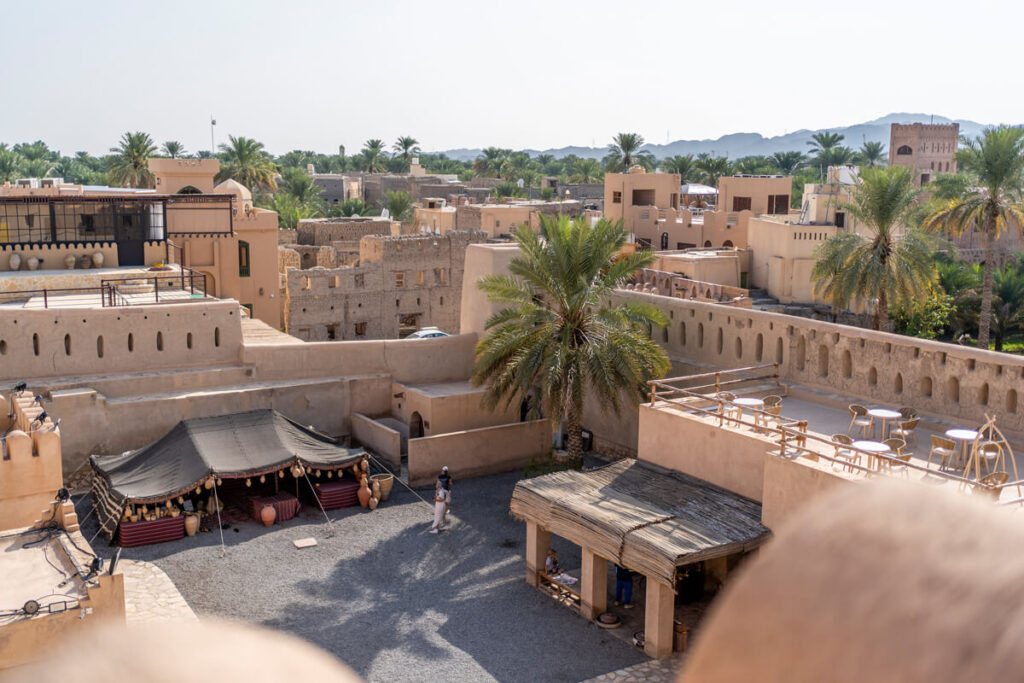
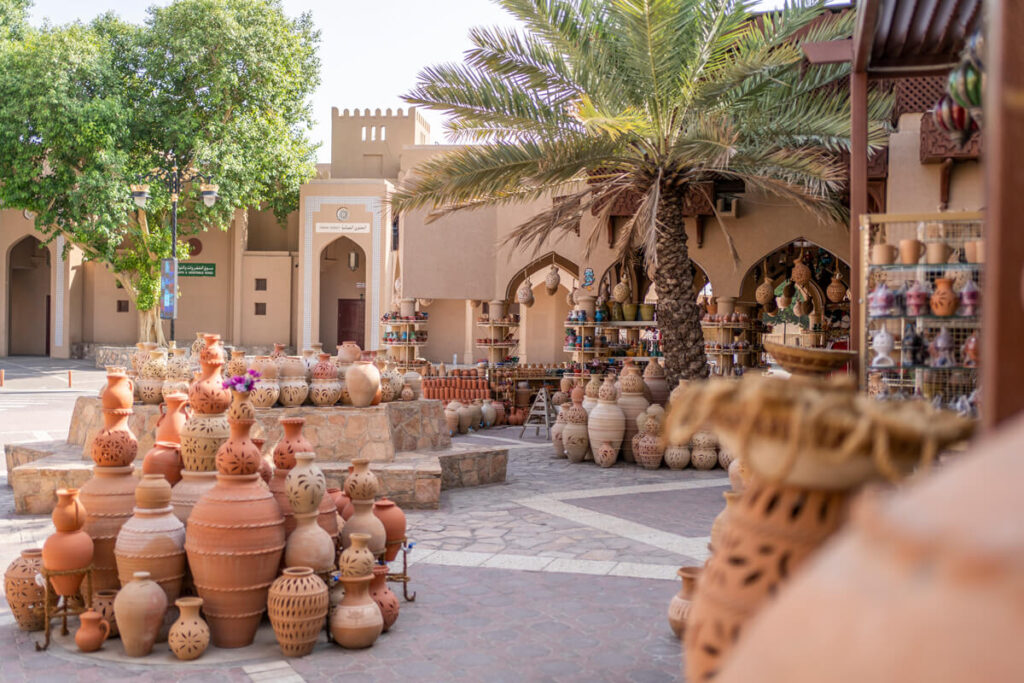
Day 5 – Jebel Shams
New day, new adventure. With your rental car, you’re finally heading into the mountains. From Nizwa, it’s only a 2-hour drive to your destination. Here you’ll find Jebel Shams, which, at 3,009 meters, is the highest mountain in Oman. From various vantage points, you have a gigantic view of Oman’s “Grand Canyon” (Wadi Nakhar). In some places, it drops almost 1,000 meters. Insane!
Hotel tips for the mountains:
- Sama Heights Resort*
- Jabal Shams Domes*
- Jabal Shams View Stay*
- Jebel Shams Resort*
- Jabal Shams Mountain Rest House*
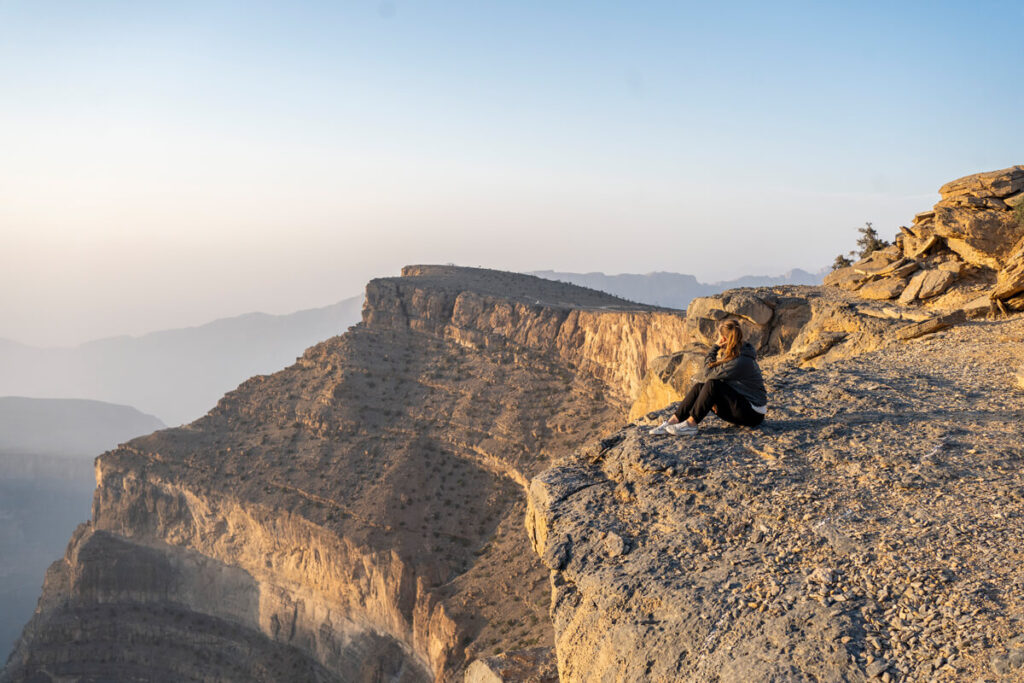
Our starting point was the Sama Heights Resort. By car, it only takes 5 minutes to reach the many beautiful viewpoints. Not far from here is the starting point of the so-called “Balcony Walk,” which is part of the W6 hiking trail. The hike is not demanding and leads along the entire length of the canyon. Plan on 1.5 to 2 hours. More information here: Balcony Walk & Jebel Shams.
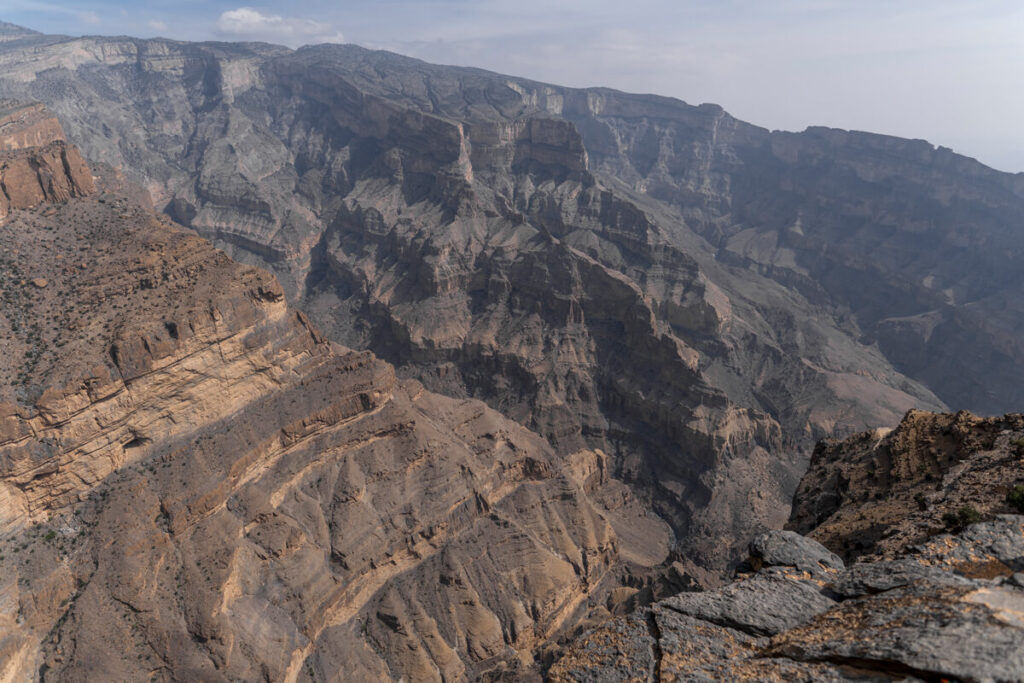
Day 6 – Misfah al Abriyyin
Today, we leave the mountains and head to the small, charming mountain village of Misfaht Al Abriyyin, which lies at an altitude of almost 1,000 meters. A special feature of the village are the terraced fields that the residents have cultivated for agriculture for centuries. Date palms and bananas, in particular, thrive here.
Through the traditional irrigation system known as “falaj,” locals channel water from the surrounding mountains through underground and open canals to their lush terraces and gardens. Stroll through the village’s narrow streets and enjoy the view from one of the terraces. Rogan’s Café and Café Halwa Coffee are recommended. Both offer great terraces with views.
Hotel tips for Misfah al Abriyyin
- Al Misfah Hospitality Inn*
- Misfah Old House*
- Bait Baityn*
- Basmat al Misfah*
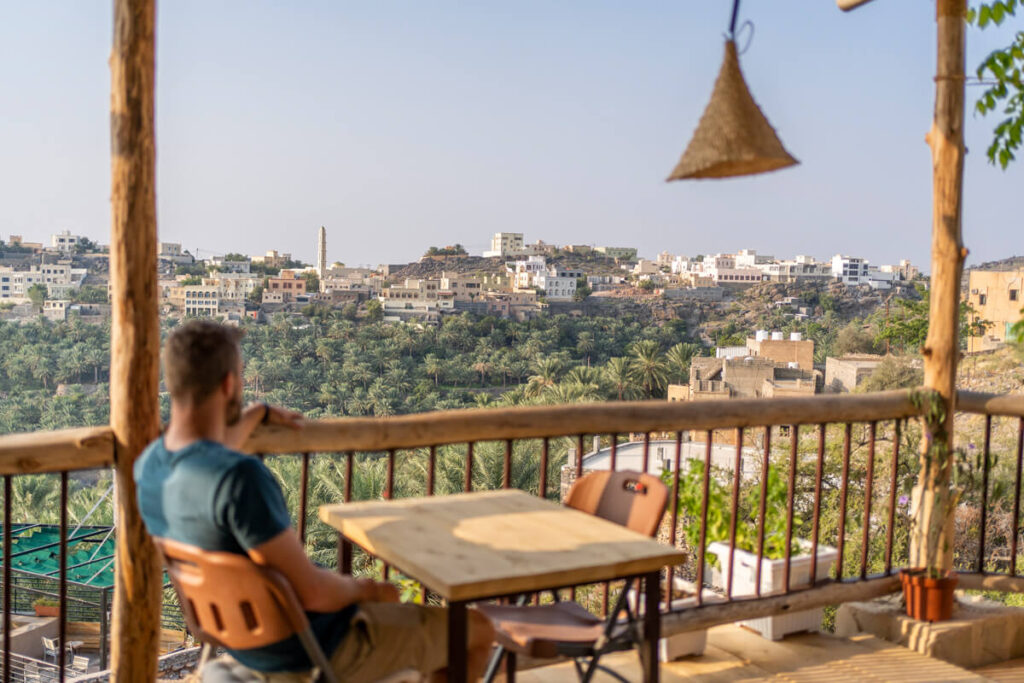
Day 7 – Ibra & Wahiba Sands Desert
Today we head to the town of Ibra, one of the oldest towns in Oman, just under 200 km away. The famous market and traditional architecture are particularly worth seeing. Check out the massive Ibra Castle, which has been completely restored, or the former government palace, Bait-al-Kabir, dating back to 1650. Every Wednesday, Ibra also hosts the famous Women’s Market. This market is run by women for women and is located right next to the city hospital. Men are still not welcome in the covered area.
Background: In the past, pregnant women were examined every Wednesday. Travel to the hospital was expensive, so the women sold handicrafts there. Eventually, they were given their own space for their stalls.

Your journey now takes you to the magical Wahiba Sands Desert. This vast desert region stretches over approximately 12,500 square kilometers and is known for its beautiful sand dunes, which can reach up to 150 meters in height. While the desert was once inhabited by Bedouins (nomads), today there are numerous accommodations for tourists.
Enjoy a night under the clear starry sky, marvel at the gigantic Milky Way, and enjoy the absolute silence and tranquility of the desert. You can either drive to your camp yourself (if you have a 4×4) or have someone pick you up at the meeting point and drive you there. The starting point is usually the small town of Al Wasil. You can read more about it here: Our camp in the desert.
Accommodations in the desert:
- Bubbles Domes Private Camp*
- SAMA Al Areesh Camp*
- Alsarmadi Desert Camp*
- Thousand Nights Camp*
- Thousand Stars Desert Camp*
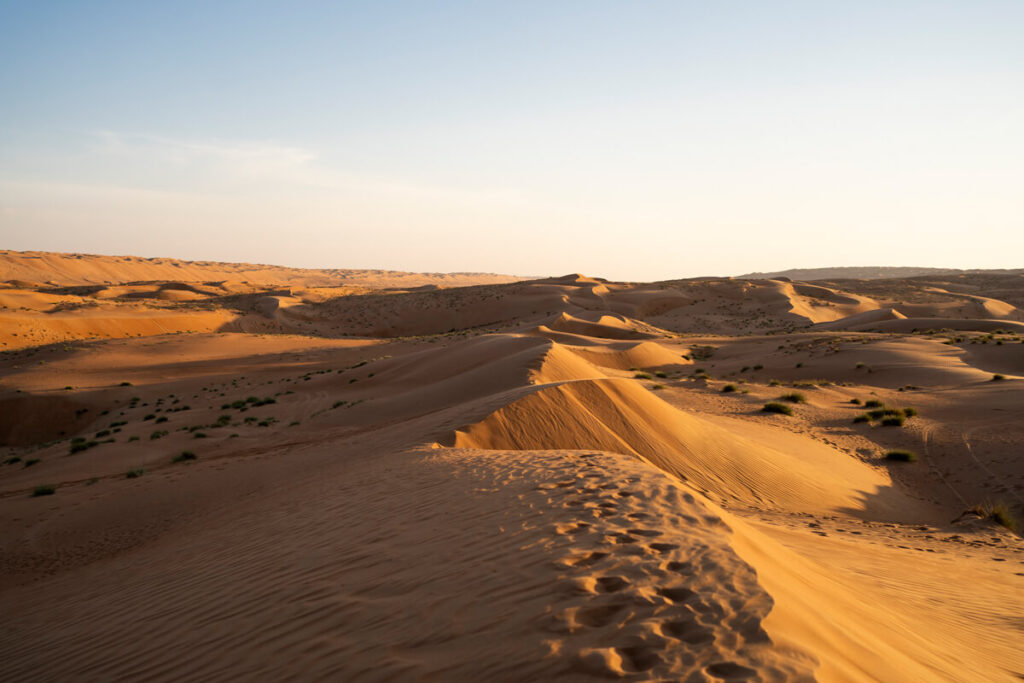 Powered by GetYourGuide
Powered by GetYourGuide
Day 8 – Wadi Bani Khalid and Sur
One moment you’re in the desert and the next you’re in a lush wadi surrounded by mountains. Welcome to Oman! After breakfast, you’ll return to civilization from your desert camp. It’s just under 50 minutes to the beautiful Wadi Bani Khalid. Lush green oases, deep rock pools, rugged rock formations, and tall palm trees await you here. Don’t forget your swimsuit, because you can take a dip in the cool water here. More about this here: Wadi Bani Khalid.
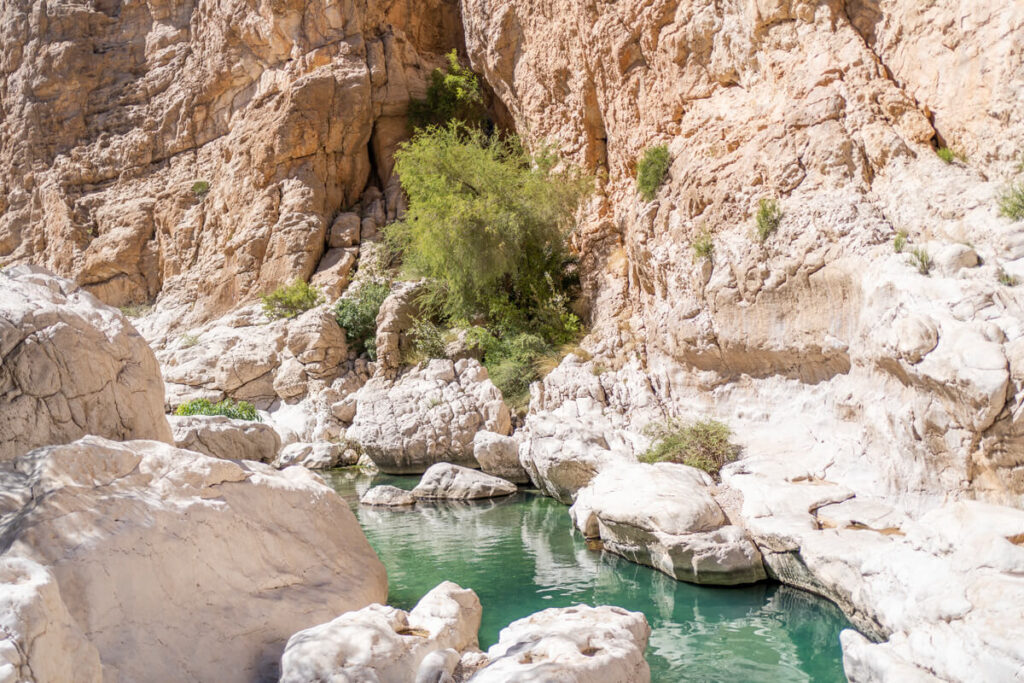
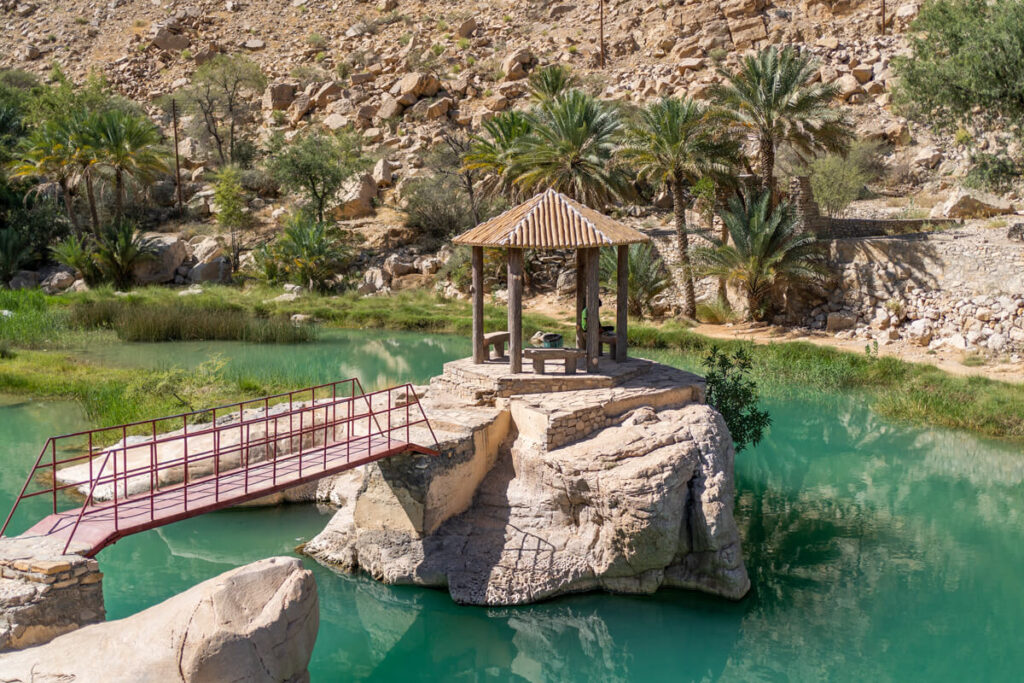
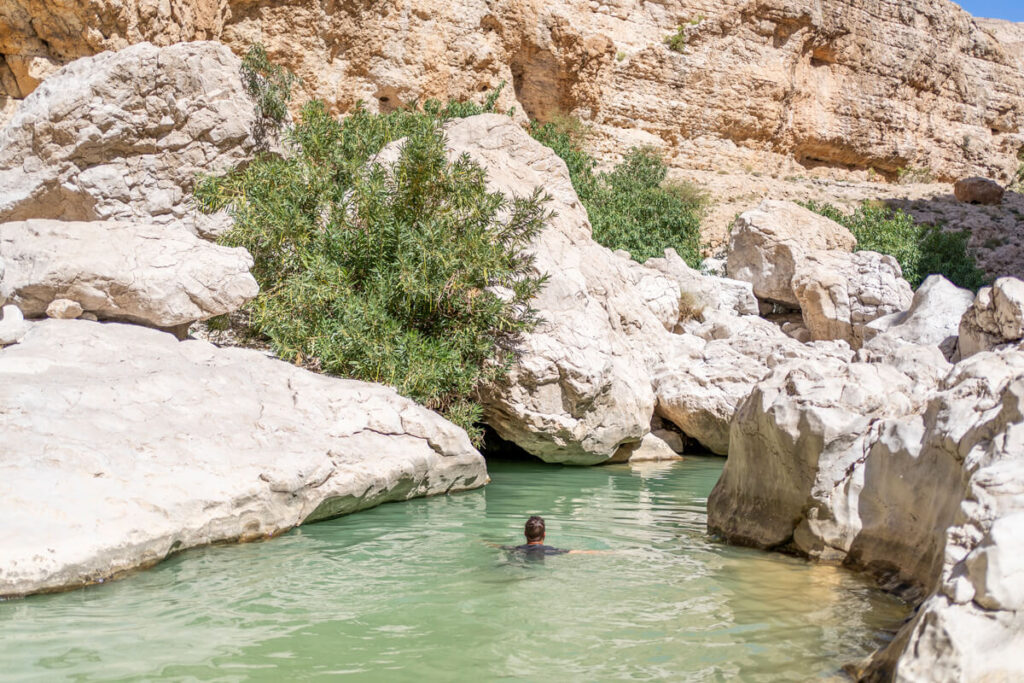
After this little adventure, we continue to the port city of Sur, which is still known for shipbuilding and an important center for the construction of dhow sailing ships. See these ships in the dhow shipyard and learn more about this centuries-old tradition.
Also worth seeing is the 16th-century Sur Fort, which sits atop a rock on the coast. Directly by the sea stands the pretty Al-Ayjah Lighthouse, which is best photographed from Sur Beach. More about this here: Port City of Sur in Oman.
Hotel tips for Sur:
- Sur Plaza Hotel*
- Sur Grand Hotel*
- Arkan Al Barzah Hotel Apartment*
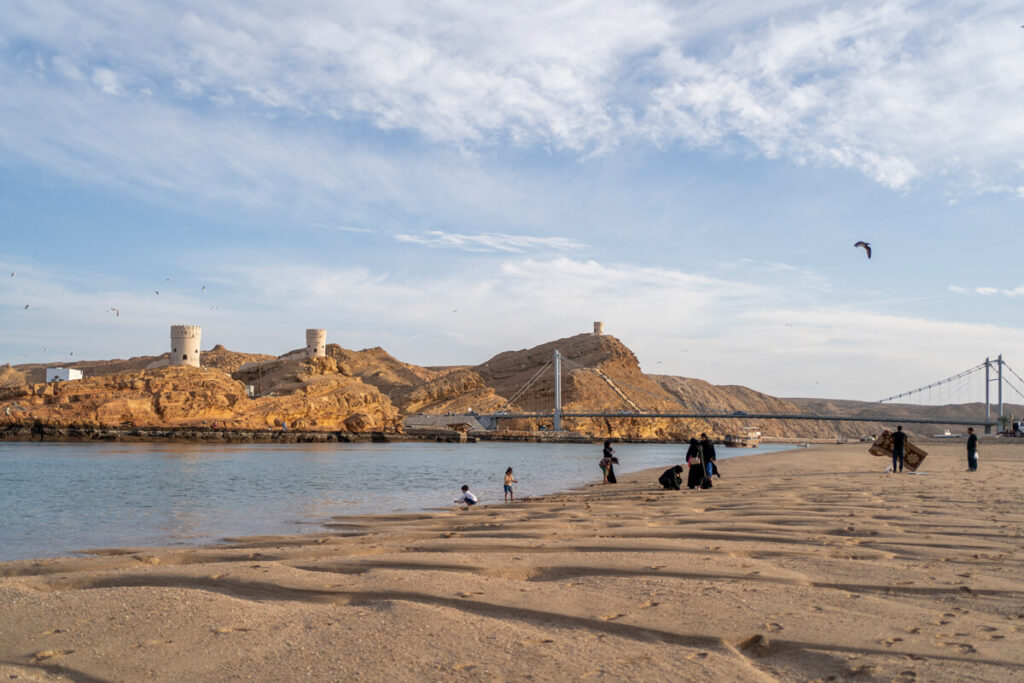
Day 9 – Wadi Shab & Wadi Al Arbeieen
Today you have two wadis on your program. You should start early in the morning when Wadi Shab isn’t so busy yet. It’s certainly one of the most touristy spots in the country, but a visit is still worthwhile. Your trip begins at the small boat dock, where locals will take you to the other side of the river for 1 rial per person (cash only!!!). From there, you’ll hike for about 45 minutes through the beautiful landscape before reaching the natural pools.
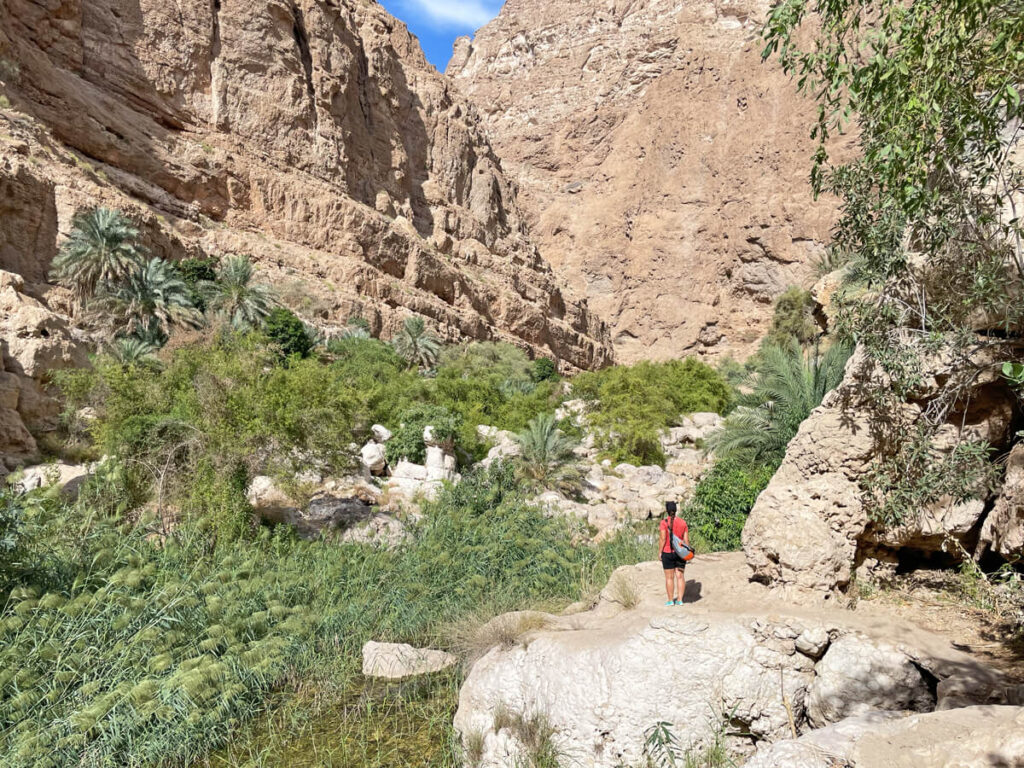
You can stay at the natural rock pools, swim, and sunbathe there. Anyone who wants to venture into the cave on a little adventure should put on water shoes and swim the approximately 300 to 400 meters (there is no other way in). Shortly before the cave, you have to go through a VERY NARROW crevice. The short tour is worth it, as there is a small waterfall in the cave.
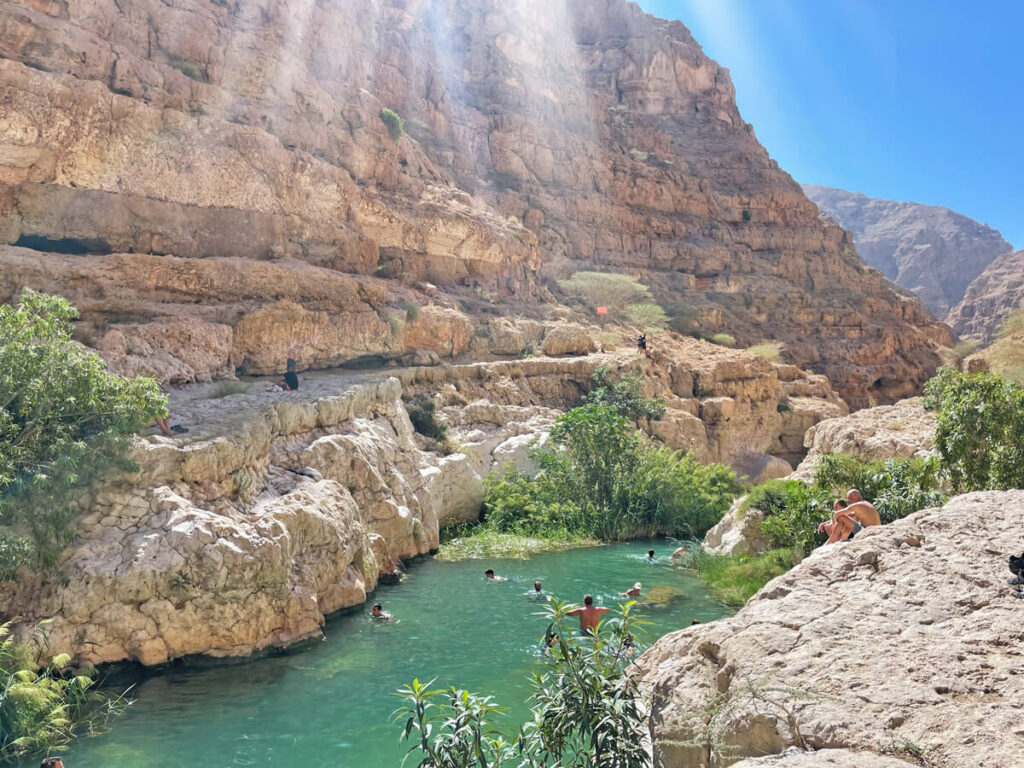
From Wadi Shab, your Oman road trip will take you past the Bimmah Sinkhole before you turn left into Wadi Al Arbeieen. This wadi is surrounded by a stunning mountain landscape characterized by rocky formations, steep cliffs, and green palm groves. Numerous natural rock pools and waterfalls can be found within the wadi. We spent our last night at the very well-located Wadi Al Arbeieen Resort*, which we can definitely recommend!
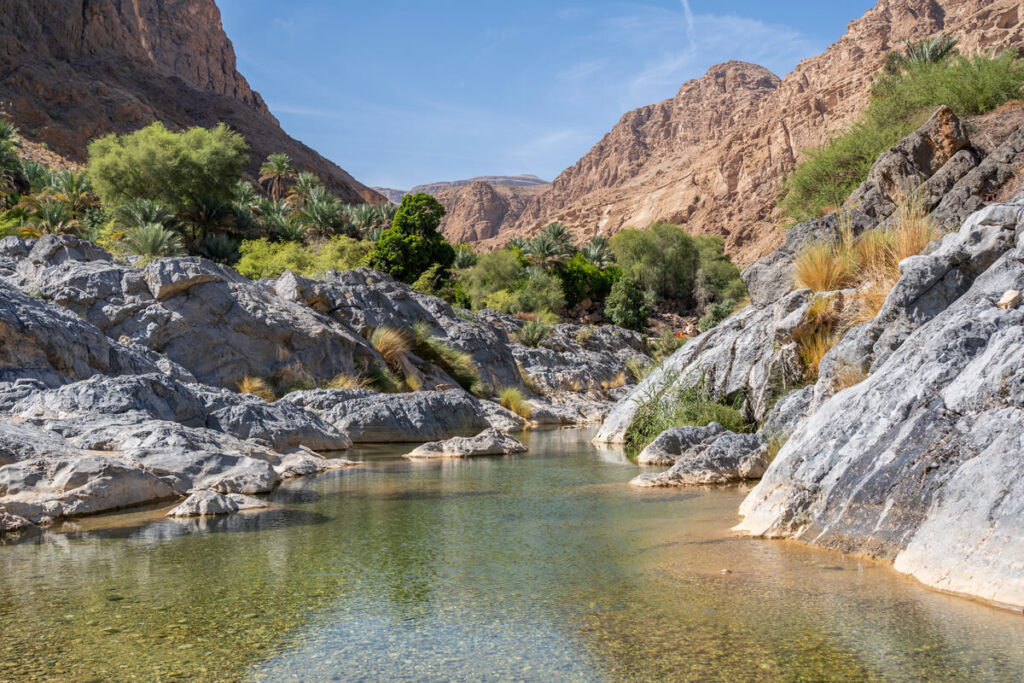
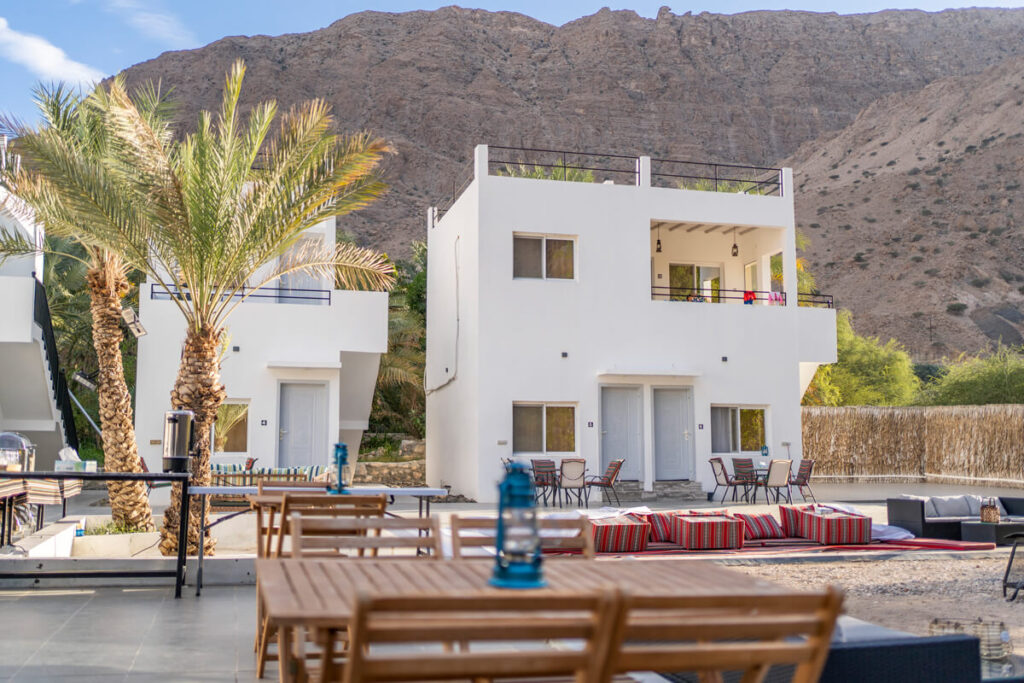
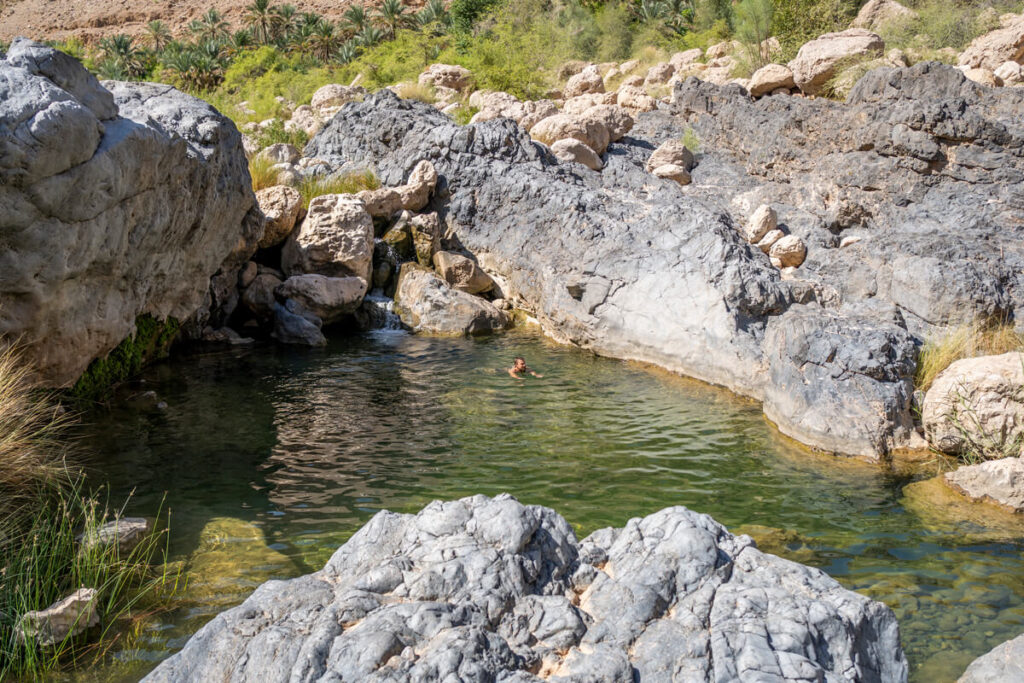
Day 10 – Return and Departure
The last morning in Oman. Your trip is now slowly coming to an end, and it’s time to head back to Muscat. The 140 km journey to the capital will take just under two hours. Pick up your last souvenirs, treat yourself to one last delicious meal, and then head to the airport to return the rental car. After we had finished everything, we ended the evening comfortably in the Prime Class Lounge at the airport.
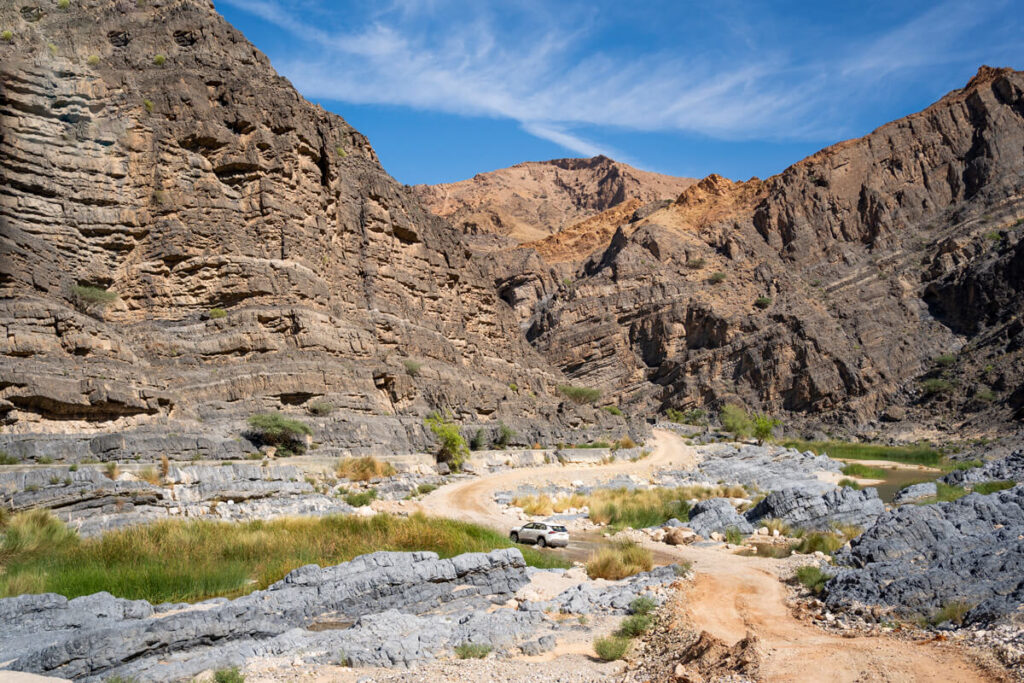
General Oman Travel Tips
Arrival – How do I get to Oman?
The main airport in Oman is Muscat International Airport (airport code: MCT), which is located in the capital city of Muscat. Another major airport in the south of the country is located in Salalah, which is often used to travel between the north and south of the country.
We started our trip from Munich with Etihad Airways via Abu Dhabi. Alternatively, Oman Air and Lufthansa offer direct flights from Munich or Frankfurt. The low-cost airline SalamAir also flies directly from Munich to Muscat.
If a stopover is not a problem for you, there are also options to fly with airlines such as Turkish Airlines (via Istanbul), SWISS (via Zurich), Emirates (via Dubai), or Qatar Airways (via Qatar). These airlines usually have stopovers at their respective hubs.
Entry – What do I need to consider when entering the country?
To enter Oman, you need a valid passport that is valid for at least six months beyond your planned departure date. According to current information from the Omani Ministry of Foreign Affairs, you do not need a visa for trips of up to 14 days. For trips lasting 15 to 30 days, you must apply for the 26B Tourist Visit Visa in advance. Fortunately, this is easily done via the Royal Oman Police website.
- 26B Tourist Visit Visa (single entry) – 20 OMR (approx. €47)
- 36B Visit Visa (multiple entry) – 50 OMR (approx. €117)
Rental Car – Do I really need a 4×4?
For our trip, a four-wheel drive vehicle was necessary, as we wanted to drive into the desert ourselves, among other things, and also into one or two wadis. However, you don’t necessarily need a 4×4 for the standard highlights. You can even drive into the mountains (Jebel Shams) with a regular car. You would then have to organize the trip into the desert with a pre-booked transfer.
With a 4×4, you have a better driving experience, more ground clearance, and more power. Driving on unpaved roads is simply easier. There are some routes we would have been very reluctant to take with a normal car, such as the ones into the mountains (Jebel Shams) or Wadi Al Arbeieen. So, the surcharge of approximately €300 was more than worth it for us.

Travel Time – When is the Best Time to Travel to Oman?
The best time to travel to Oman varies depending on individual preferences and planned activities. Generally, you can travel to the country year-round, as the climate varies from region to region. However, winter, from November to February, is often cited as the best time to travel.
Daytime temperatures range between 20 and 30 degrees Celsius, while the nights are cooler. This time of year is particularly suitable for outdoor activities and sightseeing tours.
The summer months from May to September, on the other hand, can be very hot, especially in the coastal areas and the desert, where daytime temperatures can often exceed 40 degrees Celsius. If you can handle the heat well and enjoy water sports, the summer months could be a good fit.
The mountainous regions offer more pleasant temperatures during this time. Nevertheless, we recommend the months between October and March for a visit to Oman. You can find more information on this topic in our detailed article here:
Safety – How safe is a trip through Oman?
Perhaps the good news right at the start: Oman is one of the safest countries in the world. In 2017, the country reached 4th place in a global ranking by the World Economic Forum (WEF), just behind Finland, the UAE, and Iceland. The country places great importance on the safety of tourists and locals. Various measures have been taken to ensure this safety within the country.
Oman enjoys an excellent reputation for political stability and low crime rates. Crime is generally virtually unknown and is punished consistently and severely. Our experience in Oman was extremely positive and safe. We have rarely felt as comfortable and protected as we did there. There were no negative incidents.
The locals are exceptionally friendly, helpful, and open to visitors. At no point did anyone try to take our money or steal anything. We were even able to leave our personal belongings in the car without worrying about theft. Therefore, we can answer the question of whether Oman is a safe travel destination with a clear “YES.”
Costs – How much does such a tour cost?
How much a trip to Oman ultimately costs depends on your needs. We spent approximately €2,250.00 per person on our 17-day round trip. With only 10 days, such a trip would of course be significantly cheaper. You can find a detailed article on this topic here:
Packing List – What Shouldn’t Be Missing in Your Luggage?
There are a few things you shouldn’t forget to pack if you’re going on an Oman road trip. There will certainly be a detailed Oman packing list in the future with all the information on our clothing, technology, and other gadgets. However, we have listed the most important things below:
Short packing list for the Oman road trip
- light and breathableActive clothing (preferably muted colors)
- Headgear (cap, hat, scarf) & sunglasses
- Sunscreen with a high SPF & mosquito repellent
- Water shoes* and dry bag* (especially for the wadis)
- Power adapter* (type G plug) and USB hub*
- Power bank* for charging on the go
- Daypack for excursions
- Travel credit cards for withdrawing money and paying in Oman
- Flashlight/headlamp for nighttime activities